Knowledge of Pregnancy Danger Signs and Associated Factors Among Pregnant Women in Ambo Distinct, West Shewa, Oromia, Ethiopia, 2020
Tigist Zeleke1, Elias Teferi Bala2, Berhanu Senbeta Deriba3, Degemu Sahlu3* and Diriba Gemeda3
1Oromia Regional Health Bureau West Shewa Zone, Ambo District Health Office, Ambo, Ethiopia
2Department of Public Health, Ambo University College of Medicine and Health Sciences, Ambo, Ethiopia
3Department of Public Health, Salale University College of Medicine and Health Sciences, Fitche, Ethiopia
Submission: July 04, 2023; Published: October 03, 2023
*Corresponding author: Degemu Sahlu, Department of Public Health, Salale University College of Medicine and Health Sciences, Fitche, Ethiopia, Email: kergadegemu@gmail.com
How to cite this article: Tigist Zeleke, Elias Teferi Bala, Berhanu Senbeta Deriba, Degemu Sahlu* and Diriba Gemeda. Knowledge of Pregnancy Danger Signs and Associated Factors Among Pregnant Women in Ambo Distinct, West Shewa, Oromia, Ethiopia, 2020. Glob J Reprod Med. 2023; 10(4):555792. DOI: 10.19080/GJORM.2023.10.555792.
Abstract
Background: More than half a million women are still dying annually as a result of complications of pregnancy and childbirth globally. Knowledge of the danger signs of obstetric emergencies when they occur may empower women to make prompt decisions to seek care and reduce delays in decision-making and in reaching health facilities. In our study setup, there is no study on this topic.
Objective: This study aims to assess the knowledge of pregnancy danger signs and associated factors among pregnant women in the Ambo district, West Shewa, Oromia, Ethiopia, 2020.
Method: A community-based cross-sectional study with 355 pregnant women residing in the selected kebeles of the Ambo district was selected by using a simple random sampling technique. A structured and pretested questionnaire was used for data collection and an interview technique was also used.
Result: According to the findings of this study, 29% of respondents (95%CI of 24.5-33.8) were aware of danger signs during pregnancy. Age, occupation, number of ANC visits, and access to information about danger signs of pregnancy and place of delivery are independent factors for knowledge of danger signs during pregnancy among pregnant women in the study setup.
Conclusion: The prevalence of knowledgeable individuals about danger signs of pregnancy among pregnant women was very low, so improve knowledge by improving antenatal care quality, educating women, with a special emphasis on the mother’s age, access to information, antenatal care, and place of delivery.
Keywords: Ambo district; knowledge of the women; Pregnancy; Danger signs, Oromia
Introduction
All pregnant women are at risk of unexpected changeable complications, which can result in death or injury to themselves or their infants [1]. Globally, attention to maternal health and safe motherhood has grown significantly to reduce maternal deaths, which are estimated to be 289,000 in 2013. Sub-Saharan African countries account for about 62% (179,000) of maternal deaths, including Ethiopia [2]. A high-risk pregnancy is one in which the health or life of the mother, infant, or both is jeopardized due to a disorder coincidental with or unique to pregnancy [3]. Poor obstetric history, short stature (1.52 m), extremes of maternal age, very young maternal age (15 years), and advanced maternal age (35 years) are all reported obstetric risk factors. The latter is associated with several adverse pregnancy outcomes, including preterm birth, low birth weight, stillbirth, chromosomal defects, labor complications, and higher rates of cesarean section. Internationally, more than half a million women are motionless, dying annually as a consequence of complications of pregnancy and childbirth. 99 percent of these occur in developing countries, with 50 occurring in Sub-Saharan Africa [3]. Hemorrhage, infection, unsafe abortion, hypertensive disorders of pregnancy, and obstructed labor are the major complications that account for more than 70% of all maternal deaths, and the underlying causes of these deaths are poverty, inadequate, inaccessible, or unaffordable health care, unequal access to resources, low status of women, inadequate information, and a lack of knowledge of recognizing danger signs [4,5].
The three delays, so as to the majority of maternal deaths considered to occur, are: delay in deciding to seek appropriate care; delay in reaching an appropriate health facility; and delay in receiving adequate emergency care once at a facility [6]. Thus, increased knowledge of danger signs of pregnancy is essential for dropping the first and second delays in seeking health care and in attaining a health facility.
Danger signs of pregnancy are symptoms, not clinical diagnoses, of obstetric complications that may assist women in recognizing and receiving care for a life-threatening problem more quickly, which is one aspect of problem recognition at the individual level [7]. Danger signs in pregnancy are vaginal bleeding, severe headache, severe vomiting, swelling of hands and face, difficulty in breathing, abnormal body movement, highgrade fever, reduction or absence of fetal movement, and leakage of liquor [1]. Therefore, this study aims to assess the knowledge of pregnancy danger signs and their associated factors.
Methods and Materials
Study area and period
The West Shewa Zone’s Ambo district served as the site of this study. Ambo is located in the western region of Oromia, 114 kilometers from the nation’s capital, Addis Abeba. The district includes 33 kebeles and, according to the 2019–20 year plan of the Ambo District Health Office, there are 3405 development army leaders among its projected 141,669 total residents. 5242 of them were pregnant, based on the predicted population. The district is spread over 35.5 highlands, 50 middle lands, and 14.70 lowlands. The district’s average annual rainfall is between 800 and 1000 mm, and its average annual temperature ranges from 150 to 290 °C. The district rises from 1380 to 3030 meters above sea level. There are five health facilities in the district.
Study design and study population
A community-based cross-sectional study was conducted. All pregnant women who were living in the Ambo district were the source population of the study, while the study population was all self-reported and registered on the registration book at the health post by health extension workers in the selected kebeles of the Ambo district. All pregnant women who had been living in the Ambo district for at least six months were included in this study, but women who were seriously ill or mentally unstable enough to respond to questions during the study period were excluded.
Sample size determination and sampling technique
Sample size determination: Sample size are determined by single population proportion formula [𝑛 = (𝑍𝛼/2)2 𝑝 (1 − 𝑝)/ 𝑑2] using the assumption; 95% confidence interval,5% degree of precision or margin of error, Proportion of women who know danger signs of pregnancy assumed to be 30% [8].
Sampling size concerning the determining factors of pregnancy danger signs and its associated factors is calculated using the double population proportion formula for relevant variable including maternal age, pregnancy status, number of pregnancies, gestational age, umber ANC of visits. The sample size was found to be less than that of knowledge of danger signs of pregnancy. The calculated sample size provided a total of 323 pregnant women. Finally, considering a 10 non-response rate the final sample size becomes 355.
Sampling technique: A simple random sampling technique was employed to select kebeles and estimate the number of respondents in the Ambo district. The calculated sample size was allocated proportionally to the randomly selected kebeles in the woreda based on the average number of pregnant women expected during the study period.
Study variable: The dependent variable of the study was knowledge of pregnancy danger signs, while the independent variables were sociodemographic factors including age, educational level, marital status, and occupation; obstetric related like gravidity, parity, and number of children; antenatal care-related variables including; Informed about danger signs, information source, number of ANC visits, ANC visits, and access to information.
Operational definitions
Danger signs of pregnancy: Are symptoms but not clinical diagnoses of obstetric complications that may help women to recognize without any clinical background. These are vaginal bleeding, severe headache, severe vomiting, swelling of hands and face, difficulty in breathing, abnormal body movement, high grade fever, and reduction or absent fetal movement and leakage of liquor.
Knowledge: In this study knowledge refers to correct responses of pregnant women on items regarding danger signs of pregnancy as measured by structured knowledge questionnaire.
Knowledgeable: Pregnant women who is able to answer greater than mean value of the questions prepared to assess their knowledge of the pregnant women on danger signs of pregnancy
Not knowledgeable: Pregnant women who did not answer less than mean value of the questions prepared to assess the knowledge of the pregnant women on danger signs of pregnancy.
Data Collection tool and procedures
Data were collected by using pretested, structured questionnaire that consists of socio-demographic information, knowledge of danger signs of pregnancy, previous obstetric characteristics and current ANC follow up characteristics. The tools were developed by reviewing related literatures [8-12]. It was prepared in English language and translated in to Afaan Oromo and then translated back to English to check for clarity, consistency and completeness. The tool was prepared to assess the knowledge of pregnant women on danger signs of pregnancy. Data was collected by recruited and trained data collectors. Data collectors were those who were trained in data collection for one day. One data collection facilitator and one supervisor were selected from each kebeles and training was given for one day on aim of the study, clarification of some terms, concerning need for strict confidentiality of respondent’s information, assessment tools, time of data collection, timely collection and reorganization of the collected data from respective kebeles and submission on due time. The questionnaire was filled by health extension workers and data was collected for 35 days including training and pretest, facilitated by facilitator and supervisor of the data collection.
Quality control and management
The questionnaire was prepared in English and translated into local language Amharic and retranslated into English to check its consistence. For one day, data collectors were trained on the objectives of the study, the sampling technique, the questionnaire, and how to evaluate the completeness of questionnaires. To assure data quality, all completed questionnaires were reviewed for incompleteness and inconsistency. The investigator also met with the supervisors to discuss how to manage the data collectors and how to fix difficulties that arose throughout the data collection process. Nurses with a B.Sc. degree oversaw the data collectors. Furthermore, a pre-test was administered to 5% of the total sample size from various high schools to guarantee completeness and consistency in giving the information required for the study.
Data management and analysis
The collected data was entered by using Epi-Data version 3.1 (the EpiData Association, Odense Denmark) and then exported into the Statistical Package for Social Sciences (SPSS) version 23.0 for analysis. Descriptive statistics were used to summarize the variables. Figure and tables were also employed to summarize frequencies and percentages of the variables. Both bivariable and multivariable logistic regression analysis were computed to identify factors. Variables with a p value of <0.02 during a bivariable analysis were incorporated into the multivariable logistic regression to control the possible effects of confounders. Adjusted odds ratio (AOR) with corresponding 95 confidence interval (CI) were computed to see the strength of the association and a p value of <0.05 was considered statistically significant. In addition, the Hosmer and Lemeshow test was utilized to test the goodness-of-fit of the final logistic regression model and provided a p-value of 0.03.
Result
Socio-economic characteristics of study participants
The mean (+ SD) age of the study participants was 30.67(+7.5). Two hundred fifty-one (70%) mothers were attended primary school and twenty-eight (7.9) were attend college and above. Eighty one percent of respondents are married. About half (49.3) of participant were orthodox in religion and 343 (96.6%) were Oromo ethnic group. The majority of the study participants (83.3%) of mothers were house wife. As well as two hundred eighty (78.9%) of husbands are farmer in occupation where 22(6.2%) are merchant. The education level of the husbands one hundred ninety-six (55.2%) was primary school and 80 (22.5%) unable to right & read (Tables 1, 2).
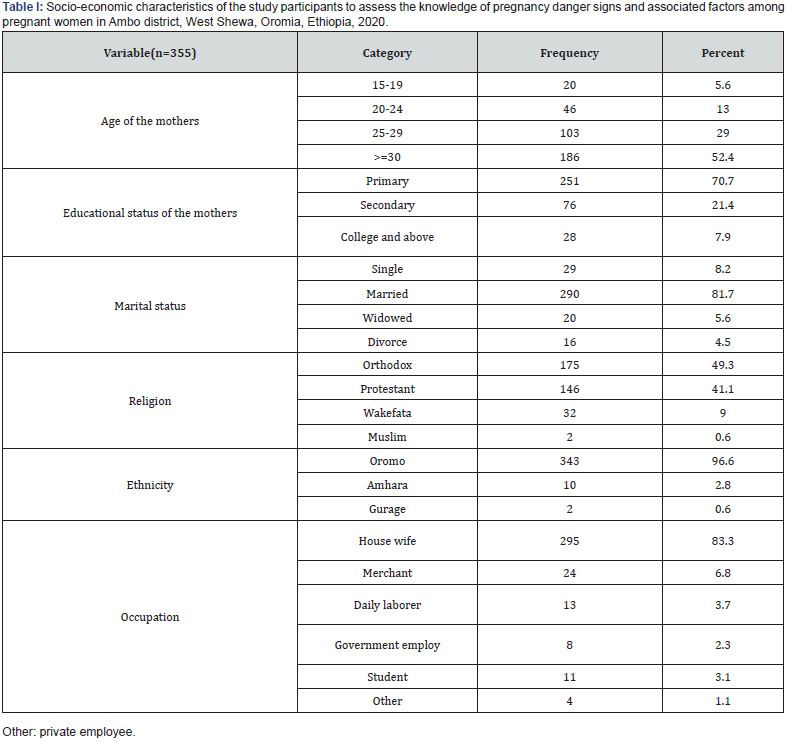
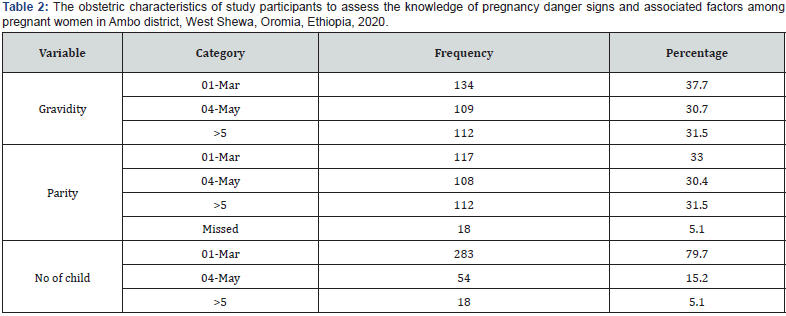
Obstetric variable
Regarding to obstetric characteristics one hundred thirty-four (37.7%) were gravida 1-3 and 112 (31.5%) through >5 gravid as well as 117(33%) are through 1-3 parity. From all respondent 283 (79.9%) have >5 children and (43.7%) are deliver her recent baby at health center and (36.3%) of participant are delivery at home 9 (Figure 1).
Knowledge of danger sign of pregnancy
Among 355 respondents, 328(92.5) of respondents had information about danger sign during pregnancy; however, 27 of them had no knowledge of danger sign during pregnancy. The source of information about danger sign of pregnancy were 264(74.4) from health institution 20(5.6) from relatives, 28(7.9) from friend the rest 14(9.8) those who heard from radio & TV. From all respondent 176(49.6%) of them know vaginal bleeding as danger sign 54(15.2) convulsion, 66(18.6) sever headech,14(3.9) severe abdominal cramp,17(4.9) and 11(3.1%) have don`t know any type of danger sign during pregnancy (Tables 3,4)
Factors associated with knowledge of the mothers towards danger signs during pregnancy
To identify factors associated with knowledge of danger signs during pregnancy both binary and multivariate logistic regression models were used. Accordingly, factors that were associated with knowledge of danger signs during pregnancy under Binary logistic regression were, age category. gravidity, number of ANC visit, Access to information, educational status, occupation and place of delivery.
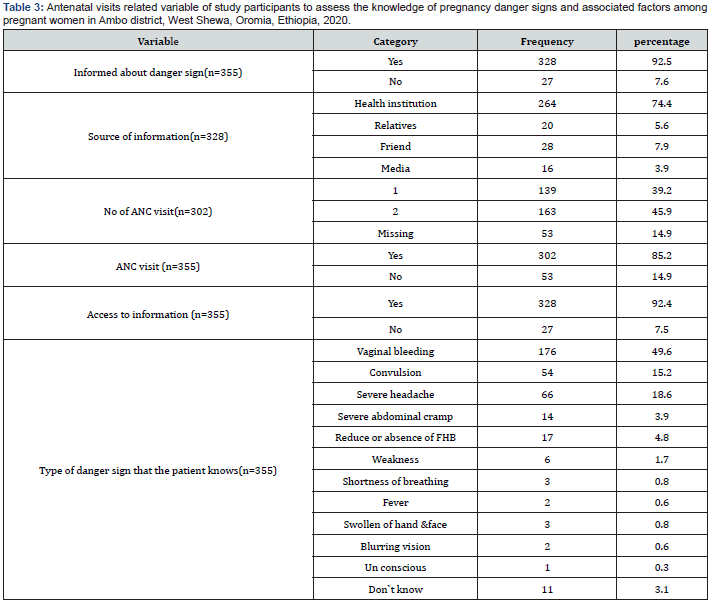
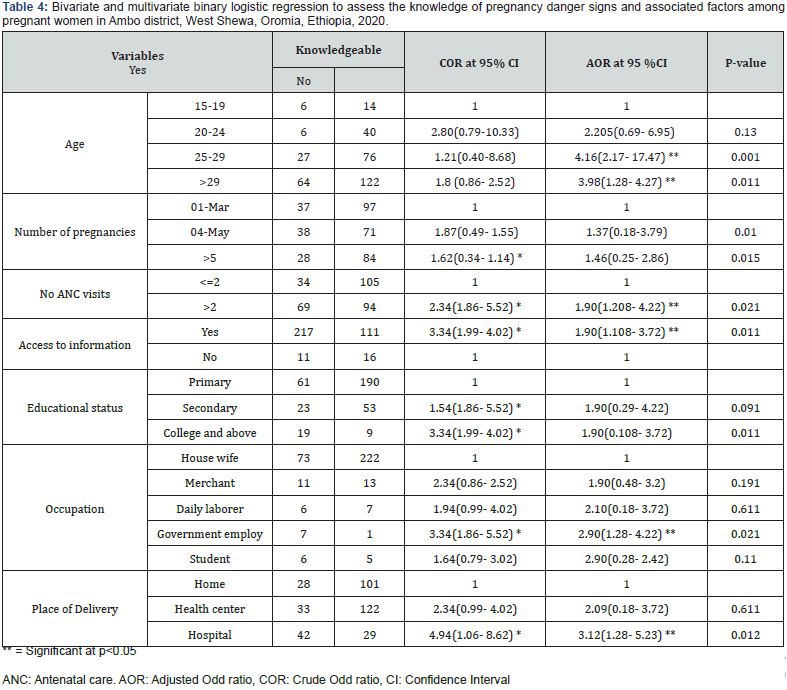
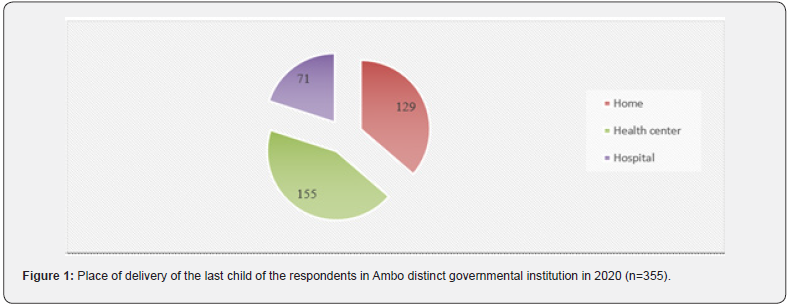
When those variables that showed significant association with knowledge of danger sign during pregnancy in bivariate analysis were adjusted for their confounders using multivariate logistic regression model, age of mothers, gravidity and number of ANC visits are independent predictor for knowledge of danger sign during pregnancy.
Discussion
The aim of this study is to assess the knowledge of pregnancy danger signs and associated factors among pregnant women in Ambo district West Shewa zone of Oromia region. On the basis of this study only 29% (CI 24.4-33.6) of the study participant were knowledgeable about the danger sign of pregnancy which is consistent with the study done at Chidambaram, India, (29.3%) [9]. The finding was lower compared to the study done at Debre Birhan town, central Ethiopia (38.6%) [10], Hawassa, Ethiopia (60.6%) [11]. The difference might be due to differences in access to the service and awareness difference among the study participants. Also, our finding lower than the studies in KwaZulu- Natal, South Africa (52%) [12] and tertiary level hospital, Nepal, India (66%) [13]. This variation could be due to topographical differences and infrastructural differences to access the service among the study participant.
The study finding is higher compared to the studies conducted in Erer district, Somali region (15.5%) [14], Arba Minch, Ethiopia (15.2%) [15], and Jordan (15.3%) [16], Uganda (19%) [17]. This difference might be due to the socio-cultural difference, study setting and difference in implementation of relevant health intervention programs on about the knowledge of danger sign of pregnancy.
In the present study, being in the age category of 25 – 29 years and above were significantly associated with knowledge about danger signs during pregnancy. Those pregnant women who were in age category of 25-29 years and above 29 years old were about 4 time more knowledgeable than those pregnant women who were in the age group of 15-19 years. This may be due to mothers in this group have better experience on knowledge of the pregnancy and more ante natal care follow up experience than younger mothers. This finding is similar with the study conducted in Wolaita Sodo town, South Ethiopia [18], but it is not consistent with study in Nekemte Town [19], Debre Tabor General Hospital, South Gondar Zone [20], Woldia general hospital, Ethiopia [21], Arba Minch General Hospital, Southern Ethiopia [15]. The difference may be due to quality of ante natal care difference and study time difference and health service accessibility difference.
Giving birth at the health institution was found to be another determinant factor of mother’s knowledge about newborn dangers signs. Women who gave birth in hospital were about three time more knowledgeable on danger sign of pregnancy compared with those delivered in home. This is similar with a study in Debre Tabor General Hospital, South Gondar Zone [20], Mechekel District Health Centers, East Gojjam Zone, Northwest Ethiopia [22]. But this finding is not similar with the study done Arba Minch General Hospital, Southern Ethiopia [15]. This difference may be due to study setting difference.
Number of antenatal cares indicated significant association with knowledge of obstetric danger signs. Mothers who attended antenatal care more than two times were nearly two times knowledgeable compared with the counterpart. This is similar to the studies in Debre Tabor General Hospital, South Gondar Zone [20], Nekemte town [19]. This is due to mothers who attend ante natal care more frequently getting more information about pregnancy and danger sign of pregnancy than those who attend less time.
Mothers’ occupation shows significant association with knowledge of obstetric danger signs. Governmental employee mothers were about 3 times more knowledgeable on danger sign of pregnancy than housewife mothers (adjusted OR with 95% CI is 2.90(1.28- 4.22). This is similar with the studies in Nekemte town [19], Woldia general hospital, Ethiopia [21].
Access to information about danger signs of pregnancy was significantly associated with knowledge of danger sign of pregnancy. Those who have access to information on danger signs were nearly two time more knowledgeable than those who have no access to the information on danger sign of pregnancy. The finding is similar with the study done in southern Ethiopia [8], Bahir Dar district, northwest Ethiopia [4].
Strength and limitation
As, a strength we employed community-based study to select the study participant which is better than institution-based study. Since the study was cross sectional, it may not be strong to demonstrate direct cause and effect between dependent and independent variables.
Conclusion and Recommendation
Based on the current study, it can be concluded that the prevalence of knowledgeable individual about danger signs of pregnancy among pregnant women were very low. The predicting factors affecting knowledge of danger signs during pregnancy were age, access to information, number of ANC visits, occupation and place of delivery.
Based on the identified gaps government body specially Ambo district health office, Health extension worker, and health workers due attention to maximize the prevalence knowledge about danger sign during pregnancy among pregnant women. This can be done by using factors affecting knowledge of pregnant women about danger sign during pregnancy take as an input and incorporate in their plan to achieve the target. Empowering women with education, promoting institutional deliveries and improving the quality of health services are the other recommended intervention.
Acknowledgments
First, we want to extend our thanks to Ambo University College of Medicine and Health Sciences for giving us to conduct research for the partial fulfillment of post graduate study.
Secondly, we would like to give our gratitude to Ambo University library staff especially post-graduation, documentation and record staffs for their cooperation.
Lastly, we would like to extend our acknowledgment to Ambo district health office head and other staff members for their friendly supporting us and give information.
Consent for Publication
Not applicable as there is no image or other confidentiality related issues.
Competing Interest
The authors declare that they have no financial nor nonfinancial competing interests.
Authors Contributions
Tigist Zeleke conceived and designed the study and analyzed data, interpreted the result and prepared the manuscript. Elias Teferi Bala, Berhanu Senbeta Deriba, Degemu Sahlu and Diriba Gemeda participat in the study selection, analyzed data, prepared the manuscript, edition of the manuscript. All author read and approved the manuscript.
Declaration
Ethical approval and consent to participate.
Ethical clearance was obtained from Rift Valley University Ambo Campus Department of Public Health. Formal letter from Rift Valley University Ambo Campus Department of public health was written to Ambo district. Informed consent was assured from participants. Finally, the participants were informed as they have full-right to participate or not to participate in the study and withdraw at any time during the interview if there is inconvenience.
Funding
We did not receive external funding for this research.
Availability of Data and Materials
The data sets used and/or analyzed during the current study are available from the corresponding author on reasonable request.
References
- WHO (2010) Mother-Baby Package. Geneva: 1994 November 21.
- WHO U, UNFPA, WORLD Bank (2012) Maternal mortality Geneva: 2005 February 10.
- Hill K, Thomas K, Zahr CA, Walker N, Say L, et al. (2007) Estimates of maternal mortality worldwide between 1990 and 2005: an assessment of available data. lancet 307:1311-1319.
- Azezu Asres Nigussie, Amanu Aragaw Emiru, Yeshalem Mulugeta Demilew, Eleni Admassu Mersha (2019) Factors associated with knowledgeon obstetric danger signs among women who gave birth within 1 year in Bahir Dar city administration, North West, Ethiopia. BMC Research Notes 12(177).
- Hogan MC, Foreman KJ, Naghavi M, Ahn S, Wang M, et al. (2010) Maternal mortality for 181 countries, 1980-2008: a systematic analysis of progress towards Millennium Development Goal 5. Lancet 375(9726): 1609-1623.
- Nikiema B, BG, JLHaggerty (1998) Providing information on pregnancy complications during antenatal visits: unmet educational needs in sub-Saharan Africa Health. Trends in maternal mortality in Ilon. Intl J Gynecol Obstet (63): 183-184.
- Mutiso SM, Qureshi Z, Kinuthia J (2008) Birth preparedness among antenatal clients. East African Medical Journal 85(6): 275-283.
- Hailu M, Gebremariam A, Alemseged F (2010) knowledge about obstetric danger signs among pregnant women in aleta wondo district, sidama zone, southern Ethiopia. Ethiop J Health Sci 20(1): 25-32.
- Felix JWA, Devi R, Manobharathi M (2018) Level of awareness about pregnancy danger signs among pregnant women attending antenatal care, Chidambaram. Int J Community Med Public Health 5(6): 2480-2485.
- Abayneh Akililu Solomon NWA, Endeshaw Admasu Chirkose, Marta Berta Badi (2015) Knowledge About Danger Signs of Pregnancy and Associated Factors Among Pregnant Women in Debra Birhan Town, Central Ethiopia. Science Journal of Public Health. 3(2): 269-273.
- Samuel Dessu ZD, Fikre Bojola (2018) Knowledge, attitude and health– seeking behavior of obstetric danger signs during pregnancy.
- Hoque M, Hoque ME (2011) Knowledge of Danger Signs for Major Obstetric Complications Among Pregnant KwaZulu-Natal Women.Asia Pac J Public Health 23(6): 946-956.
- Thapa B, Manandhar K (2017) Knowledge on obstetric danger signs among antenatal mothers attending a tertiary level hospital. Nepal JCMS Nepal 13(4): 383-387.
- Maseresha N, Kifle Woldemichael, Lamessa Dube (2016) Knowledge of obstetric danger signs and associated factors among pregnant women in Erer district, Somali region, Ethiopia. Women's Health BMC 16(30).
- Workineh Y, HD, Gultie T, Degefu N, Mihrete M, Shimeles M, et al. (2014) Knowledge of obstetric danger signs and its associated factors in Arba Minch town, Ethiopia. American Journal of Health Research 2(5): 255-259.
- Okour A, Alkhateeb M, Amarin Z (2012) Awareness of Danger Signs & Symptoms of Pregnancy Complication Among Women in Jordan. Int J Gynaecol Obstet 118(1): 11-14.
- Kabakyenga KJ, Östergren OP, Turyakira E, Pettersson KO (2011) Knowledge of obstetric danger signs and birth preparedness practices among women in rural Uganda. Reproductive health 8(33): 10.
- Alemu Bolanko, Hussen N, Kirubel Minsamo, Nigatu Addisu, Mohammed Gebre (2021) Knowledge of obstetric danger signs and associated factors among pregnant women in Wolaita Sodo town, South Ethiopia: A community-based cross-sectional study. SAGE Open Medicine 9: 1-9.
- Misganu Teshoma Regasa Jote M, Ashenafi Habte, Shivaleela PU (2020) Obstetric Danger Signs: Knowledge, Attitude, Health-Seeking Action, and Associated Factors among Postnatal Mothers in Nekemte Town, Oromia Region, Western Ethiopia—A Community-Based Cross-Sectional Study. Obstetrics and Gynecology International 8.
- Wubet Alebachew Bayih, Biniam MB, Abebaw Yeshambel, Molla Asfaw (2020) Determinants of maternal knowledge of neonatal danger signs among postnatal mothers visiting neonatal intensive care unit, north Central Ethiopia, 2019: a cross sectional study. BMC Pregnancy and Childbirth 20: 218.
- Mekdes Mengesha Jemberia, Elsa TB, Hawi Bersisa Mirkena, Destaw Molla Gishen, Abera Endale Tegegne, et al. (2018) Low level of knowledge about neonatal danger signs and its associated factors among postnatal mothers attending at Woldia general hospital, Ethiopia. Jemberia et al Maternal Health, Neonatology, and Perinatology 4: 5.
- Gedefa Amenum, Zerfu M, Tewodros Seyoum, Hinsermu Bayu (2016) Knowledge about Danger Signs of Obstetric Complications and Associated Factors among Postnatal Mothers of Mechekel District Health Centers, East Gojjam Zone, Northwest Ethiopia, 2014. Scientifica 2016: 7.






























